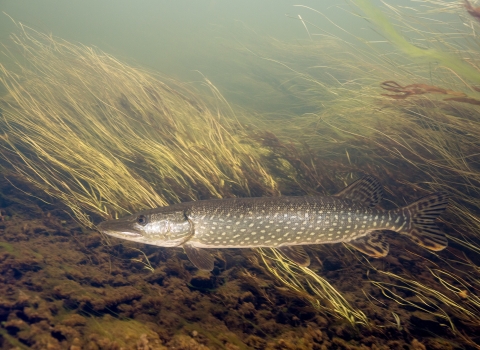Hard Water Love
Winter is a great time to fish for Burbot as they move slowly along river and lake bottoms. Burbot also spawn in winter, under the ice, in writhing masses. It’s dark, and they vocalize to each other by rapidly contracting striated muscles attached to their gas-filled swim bladder. The drumming songs they make have similar beats to those of other closely-related marine cod fishes.
Tip: If you don’t have anything to do on Valentine’s Day, may we suggest you go Burbot fishing? For you musicians, we challenge you to record the soundscape of the Burbot using a hydrophone.
A fish of many names
Burbot, eelpout, cusk, lawyer, lingcod, mudshark, tiktaalik. Some of these names are actually preferred common names for other species of fish, like lingcod—which is no Burbot, but actually a big, toothy marine fish popular in coastal Alaska waters. Sometimes it’s just best to go with the scientific name: Lota lota (as scientific names go, it’s one of the easiest to say and remember).
Fishing for Burbot
To be a successful angler, you need to know a fish—like what it likes to eat, when it eats, when time of year it breeds and migrates, and what kind of habitat it prefers. Burbot feed at night and, in Alaska, eat other fish that live where they live—Longnose Suckers, whitefishes, lampreys, sculpins, and even occasionally other burbot. They’re a well-adapted bottom predator that prefers lakes or slow moving waters…and fresh bait.
Burbot occupy most large rivers and many lakes throughout most of Alaska, except for Southeast Alaska. In the interior, Burbot are abundant in large glacial rivers— like the Tanana, Yukon, Kuskokwim, and Copper. The largest sport fisheries for Burbot are in the Tanana River, and lakes in the upper reaches of large river systems. Since Burbot are long-lived and relatively late to mature, they are susceptible to overharvest, so be sure to check the Alaska Department of Fish and Game regulations.
A set-line is a popular winter technique. An Iñupiaq technique includes under-ice fish traps which funnel these fish into a live box:
Burbot have fine, embedded scales that produce a lot of mucous and they’re slippery to hold onto. The body tapers, and finding a handle on the burbot can be difficult. Be sure to bring a rag to wipe your hands.
Cleaning, Cooking, and Eating Burbot
There are a lot of ways to cook and prepare a Burbot! Like cod, their white flesh is delicious and delicate. And their tasty large livers are a great source of vitamin D in the winter.
As always, you’ll want a sharp fillet knife and actually some pliers for a burbot with a square head and teeth on the end. There are a lot of good tutorials online about how to skin and fillet a Burbot. Some people like to soak their fillet in cold water and salt briefly to remove any slime.
Whether you like fish and chips or “poor man’s lobster” or chowder, there is a lot you can do with a nice Burbot fillet.
In Alaska we are shared stewards of world renowned natural resources and our nation’s last true wild places. Our hope is that each generation has the opportunity to live with, live from, discover and enjoy the wildness of this awe-inspiring land and the people who love and depend on it. We honor, thank, and celebrate the whole community — individuals, Tribes, the State of Alaska, sister agencies, fish enthusiasts, scientists, and others — who have elevated our understanding and love, as people and professionals, of all the fish.








